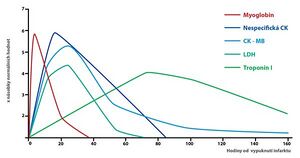The use of enzymes in diagnosis of diseases
From WikiLectures
Determining the activities of various enzymes in body fluids is often used in clinical practice to diagnose the location and extent of tissue damage. In addition to the diagnostic benefit, there is also a significant prognostic benefit, evaluated on the basis of changes in the levels of the relevant enzymes over time.
Enzyme activities are most often measured directly in plasma. It can be:
- Plasma specific enzymes – eg clotting factors.
- Secretory enzymes that enter the blood to varying degrees - e.g. pancreatic amylase or lipase.
- Intracellular enzymes performing various functions in cells – they enter the blood when the cells of the relevant tissue are damaged.
When evaluating measured enzyme levels, it is important to know their:
- Intracellular localization
- Some enzymes are specifically found only in certain compartments of the cell and can thus serve as their markers. An example would be cytochrome oxidase, which is specific for mitochondria. According to the representation of enzymes washed out of the cells, we can also estimate the degree of damage to the given tissue. If only enzymes localized in the cytosol are present in the blood, the impairment is milder than in the case of the occurrence of typically mitochondrial enzymes as well.
- Organ and tissue distribution
- Just as the distribution of enzymes within cellular compartments varies, so does their distribution between individual tissues and organs. Some enzymes are therefore more or less organ specific . Typically, these are mainly various types of isozymes or isoforms of enzymes. Examples are creatine kinase isoenzymes – CK-MB typical for the myocardium and CK-MM for skeletal muscle.
The most frequently determined enzymes[edit | edit source]
Liver[edit | edit source]
- Markers of hepatocyte damage :
- ALT (alanine aminotransferase) – located mainly in the cytoplasm,
- AST (aspartate aminotransferase) - located mainly in mitochondria.
- Since AST is mainly a mitochondrial enzyme, it is released only when liver cells are more severely damaged. The severity of the impairment can therefore be assessed according to the AST/ALT ratio.
- Markers of cholestasis :
- ALP (alkaline phosphatase),
- GGT (γ-glutamyltransferase) – its increased activity is also noted in chronic alcoholic liver disease.
Pancreas[edit | edit source]
- Pancreatic amylase – less specific for pancreatic involvement than pancreatic lipase.
- Pancreatic lipase.
Muscle tissue[edit | edit source]
To distinguish the site of damage, the activities of creatine kinase isoenzymes are measured:
- CK-MM – localized in skeletal muscle;
- CK-MB – located in the myocardium;
- CK-BB – located in the brain.
When diagnosing a myocardial infarction, in addition to CK-MB, the levels are also measured:
- Troponins I and T - currently the most specific cardiac markers, the peak of their concentration occurs about 12 hours after a heart attack.
- Myoglobin - not very specific as a cardiac marker, but it reaches its peak concentration already 2 hours after a heart attack.
Bone tissue[edit | edit source]
- ALP (alkaline phosphatase) - localized in osteoblasts - the so-called bone fraction, but it can also come from the liver (the so-called liver fraction), GIT or kidneys,
- ACP (acid phosphatase) – localized in osteoclasts, can also come from the prostate.
Lactate dehydrogenase (LD, LDH) isoenzymes[edit | edit source]
- LD-1 – localized in myocardial cells and erythrocytes.
- LD-2 – located in RES.
- LD-3 – located in the lungs.
- LD-4 - located in the kidneys, pancreas and placenta.
- LD-5 – located in the liver and skeletal muscle.
Overview of the most frequently determined enzymes[edit | edit source]
| Determined enzymes | Organ/ tissue damage |
|---|---|
| α-amylase (AMS), pancreatic lipase (LPS) | Pancreas |
| Alkaline phosphatase (ALP) | Bone, liver, GIT, kidney, placenta |
| Acid phosphatase (ACP) | Bone, prostate |
| Creatine kinase (CK) | Skeletal muscle, heart |
| Lactate dehydrogenase (LD) | Heart, liver, skeletal muscle, kidney, erythrocytes |
| Alanine aminotransferase (ALT) | Liver |
| Aspartate aminotransferase (AST) | Liver, heart, skeletal muscle |
| Gamma-glutamyltransferase (GGT) | Liver |

